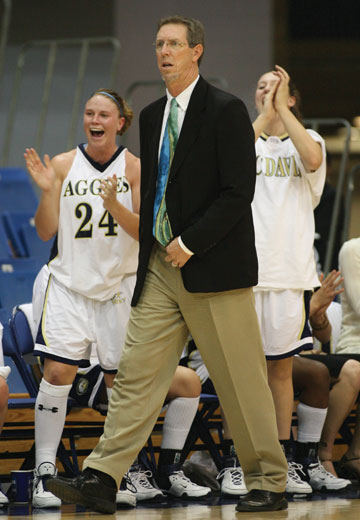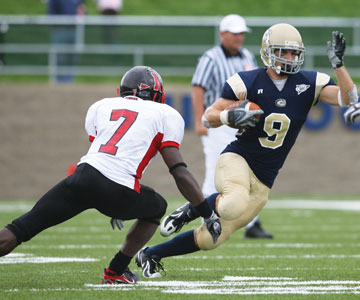Volume 25 · Number 4 · Summer 2008
Sports

Women’s basketball coach Sandy Simpson believes that finding the right player results in a positive experience for both the team and the individual athlete. (Photo: Wayne Tilcock/The Davis Enterprise)
The Recruiting Game
The challenge of attracting and finding the best.
By Mike Robles and Mark Honbo
The National Collegiate Athletic Association devotes 48 pages of its rules manual to recruiting, but in a coach’s quest to find the next All-American from millions of high school prospects, the words on those pages might be the only parts of the process that are black and white.
That’s because recruiting, arguably the most publicly followed aspect of an athletics program besides the games themselves, can be just as much fortune-telling as fact-finding and there is no universal recipe for success. What works for the football coach might not work for the rowing coach.
But at the core, the mission for UC Davis coaches is still the same: to find high school student-athletes who excel athletically, are driven academically and have the character to help the team accomplish its goals. All coaches will agree, though, it’s easier said than done.
The 2007–08 academic year was UC Davis’ first as a member of NCAA Division I following a four-year reclassification from Division II. The transition marked the biggest change in the history of the athletics program, topping the move from nonscholarship to the addition of athletics grants-in-aid a decade ago.
The evolution of the program in recent years has also meant a change in recruiting as Aggie coaches pursue student-athletes to compete at the highest levels of collegiate competition while also maintaining a long-standing emphasis on academic excellence.
Good recruiting helps to build and maintain a successful program, which explains its importance to coaching staffs. Do the right job at the front end and reap the rewards down the road.
“It’s the starting point,” said women’s basketball coach Sandy Simpson. “Obviously, once student-athletes are here we feel you have to develop them as complete student-athletes, help them be successful academically and help them grow as young adults. But athletically you have to develop them as well. If you haven’t recruited well, that job becomes much more difficult.”
Simpson and his staff scour the state, tapping coaching connections for leads and watching endless games at high schools and club tournaments, all in an effort to find the right players. Being able to project a player’s possible impact is also critical.
“It’s even more important for us than for schools from some of the bigger conferences,” he said. “Those big conferences are going to get [more] talented and polished players. We look for those players who will have an upside down the line.”
That recruiting foresight showed benefits for the Aggies this year, their first in the Big West Conference. Women’s basketball finished second in the league during the regular season and advanced to the conference tournament championship, nearly earning a bid to the NCAA Tournament in only its first year. The Aggies went on to play in the Women’s National Invitational Tournament.
Looking nationwide
Elaine Jones, who recently completed her seventh season as the Aggie head women’s lacrosse coach, faces a recruiting challenge not shared by her peers in Hickey Gym. Although her sport continues to grow rapidly in California — San Diego’s North County and San Francisco’s East Bay are relative hot spots — the fact remains that a much heavier concentration of prospective student-athletes is found in the Northeast and Mid-Atlantic states.
“In Division II, there were maybe four teams in the country with whom we were trying to be competitive,” said Jones. “In Division I, there are about 60 schools ahead of us. To compete at the higher level, you need experienced players who are used to competing against other top players. It’s imperative that we go back East.”
This is not to say that Golden State soil has proven unfruitful in Jones’ efforts to build her program over the years. The Aggies ranked among the top three teams in Division II during the coach’s first three seasons. One of her top players in that span, midfielder Kelly Albin of Fort Bragg, earned national headlines by winning the NCAA Woman of the Year and NCAA’s Today’s Top VIII awards in 2004.
More recently, Pleasanton native Katie McMahon ranked among the nation’s scoring leaders in each of her three seasons playing against Division I opponents. Hilary Harkins, a goalkeeper from Orinda, was selected to the U.S. Lacrosse National Development Team in 2006.
“We put Californians in the spotlight,” said Jones. “We put Hilary on the national development team. We put Katie in the national rankings. We’re proud of our California players. But we can’t have an all-California team and expect to compete in Division I. There are just not enough players out here.”
Making the cut academically

Joe Trombetta, a highly recruited football player, said that the educational opportunities at UC Davis played an important role in his decision to come here. (Photo: Wayne Tilcock/The Davis Enterprise)
While lacrosse requires long-distance recruiting, most UC Davis coaches focus on finding prospective student-athletes in California. Resident fees help stretch the Aggies’ grant-in-aid funds while non-resident fees can nearly double the cost of education. But wherever the prospects are found, it’s certain that academics are important to both coach and prospect.
Joe Trombetta, a standout redshirt freshman on the football team, was highly recruited out of Casa Grande High School in Petaluma. A prolific prep career in which he rushed for nearly 5,500 yards put him on the radar of several major programs, including most in the Pac-10. He said being recruited by UC Davis was different, especially when it came to educational opportunities.
Trombetta said UC Davis coaches made academics a focal point early in the recruiting process, explaining the variety of majors to choose from and the types of advising and help available to student-athletes throughout their collegiate careers. He said that type of approach was the exception rather than the norm in his recruiting experiences.
“I think by putting the emphasis on that early, instead of just emphasizing the football, it also made us see that they were interested in us as people and not just as football players,” said Trombetta.
UC Davis is one of the top public universities in the country, a fact that attracts top student-athletes while also helping whittle down a large list of prospects to a more manageable number since admission requirements are very competitive and prospective student-athletes must meet UC eligibility requirements.
But the higher academic standards prove beneficial from a coaching aspect as well.
“When you set the bar high academically, you tend to get kids who have had to achieve and are trying to be the best in every aspect of their life,” Simpson said. “It helps us to get kids who are highly motivated.”
Campus attraction
Perhaps the biggest selling point about UC Davis is the campus itself.
“I can’t tell you how impressive the campus and town are to people who have never been here before,” Simpson said. “Their expectations are completely different. When they get here and see the maturity of the campus, they fall in love with this place. If we can get them on campus, we’ve got a really good shot.”
Under NCAA rules, prospective student-athletes can visit campus either “unofficially” (they cover their own costs) or “officially” (UC Davis covers). Rules governing those visits are just some of the many coaches follow during the recruiting process.
Remember the 48 pages in the NCAA manual surrounding recruiting? Three of them are devoted exclusively to telephone calls, just one example of how detailed the process has become.
The rules are in place, Simpson said, to both level the playing field between institutions and to protect the prospective student-athlete — or “PSA” as the NCAA calls them. In fact, the NCAA has recently enacted legislation prohibiting coaches from sending PSA’s text messages since some were receiving hundreds per day.
Recruiting is a time-consuming, seemingly endless endeavor for coaches who understand the critical nature of the process. But at UC Davis, it all boils down to trying to convince a talented high school student-athlete the campus is a right fit for them.
“You don’t have to apologize about any aspect of UC Davis,” Simpson said. “The athletics experience promises to be very strong, academically they can’t go wrong and, in terms of the location and the environment, it’s terrific.”
Mike Robles is assistant athletics director and director for media relations, and Mark Honbo is assistant director of athletics media relations.
